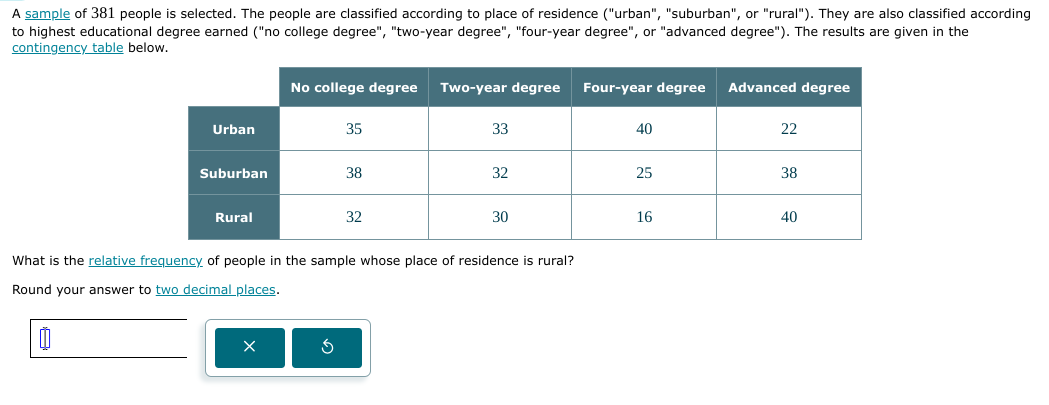What is the relative frequency of people in the sample whose place of residence is rural? Round your answer to two decimal places.

Understand the Problem
The question is asking for the relative frequency of people in a sample whose place of residence is rural. This involves calculating the proportion of rural residents compared to the total sample size.
Answer
The relative frequency is approximately $0.31$.
Answer for screen readers
The relative frequency of people in the sample whose place of residence is rural is approximately $0.31$.
Steps to Solve
- Identify the total number of rural residents
From the contingency table given, we need to find the total number of people in the "Rural" category by summing all the educational levels.
The number of rural residents for each category is as follows:
- No college degree: 32
- Two-year degree: 30
- Four-year degree: 16
- Advanced degree: 40
So, the total number of rural residents is:
$$ \text{Total Rural} = 32 + 30 + 16 + 40 $$
- Calculate the total number of people in the sample
The total sample size is provided in the question:
$$ \text{Total Sample} = 381 $$
- Calculate the relative frequency of rural residents
The relative frequency of rural residents is determined by dividing the total number of rural residents by the total sample size:
$$ \text{Relative Frequency} = \frac{\text{Total Rural}}{\text{Total Sample}} $$
- Perform the arithmetic calculations
First, calculate the total number of rural residents:
$$ \text{Total Rural} = 32 + 30 + 16 + 40 = 118 $$
Now, calculate the relative frequency:
$$ \text{Relative Frequency} = \frac{118}{381} $$
- Round to two decimal places
After performing the division, round the result to two decimal places.
The relative frequency of people in the sample whose place of residence is rural is approximately $0.31$.
More Information
The relative frequency gives an idea of the portion of the total sample that lives in rural areas. In this case, it shows that about 31% of the sampled individuals reside in a rural area.
Tips
- Failing to sum all categories in the "Rural" row: Ensure all educational levels are included before calculating the total rural residents.
- Incorrect placement of decimal points during division: Be careful when performing the division and rounding; verify the calculation for accuracy.
AI-generated content may contain errors. Please verify critical information